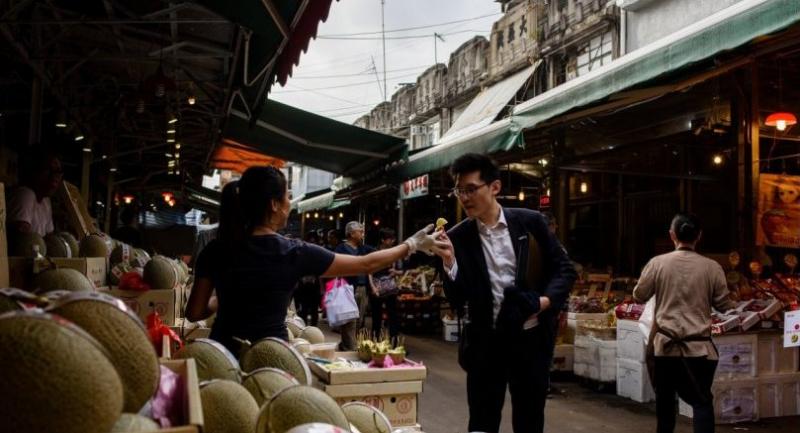Tucking into a slice of luxury

Hong Kong’s shoppers are finding themselves with empty wallets thanks to a new high-end fruit fad
IT MIGHT BE a healthy food choice, but Hong Kong’s latest fruit fad is doing serious damage to shoppers’ wallets.
From luxury supermarkets to outdoor stalls, expensive premium produce is increasingly on show and sought after by customers.
At Hong Kong’s vibrant Yau Ma Tei fruit market, a Malaysian durian goes for HK$600 (Bt2,650) and Tasmanian cherries for HK$550.
On the shelves of high-end supermarket City Super, a single Japanese strawberry recently fetched a whopping HK$168. Each strawberry nestled on a paper pillow, encased in a glossy cardboard box.
The appetite for pricey fruit from far afield reflects a quest for what punters see as clean, fresh produce, even if it has travelled thousands of miles.

A customer is offered a slice of premium Japanese melon, which costs 120 HKD (Bt530), at the Yau Ma Tei fruit market in the Kowloon district of Hong Kong. /AFP
Fruit shoppers say they do not consider produce from mainland China – the source of much of Hong Kong’s food – as healthy.
“I used to buy mainland fruit, but now I could never go back. It is not as safe and fresh,” says Peter Wong, 48, an accountant who says he spends around HK$2,000 on imported fruit each month for himself, his wife and their two children.
“The fruit is fresher if it comes from overseas, like the US or South Africa or Japan,” he says as he browses the Yau Ma Tei stalls.
Reports of farmers using excessive pesticides, fertilisers and preservatives in China have damaged the reputation of its produce, and food grown locally in Hong Kong is very limited.
The trend partly reflects a growing desire for a healthier diet, in a city where traditional dishes can be heavy on salt and fat.
But it is also about status – expensive fruit has become a popular gift to impress loved ones and colleagues, tapping in to an established Chinese tradition of giving fruit to bring good luck and prosperity.
Daniel Chan, 42, a vendor at Yau Ma Tei whose family has been running the business for 70 years, says the gifting of expensive fruit is largely related to “face”, an important element in Chinese culture to show wealth and generosity.

Fruit vendors work on a main road at the wholesale Yau Ma Tei fruit market in the Kowloon district of Hong Kong. /AFP
The family used to sell only to wholesalers, but has branched out into retail in the past two years thanks to the demand for premium fruit from wealthy customers.
“Professional, high-class people come here on Saturdays and Sundays, with their Maseratis and Ferraris and Benzs parked outside,” Chan says.
Shoppers like to see themselves as “professional” fruit buyers, able to sniff out the best produce, he adds.
The trend is not limited to Hong Kong. Japanese families and businesses routinely offer expensive fruits as presents to express gratitude.
Specialised luxury fruit parlours, often located inside high-end department stores, boast a wide selection of spotless cherries, mangoes and melons, set neatly inside cushion-lined wooden boxes.

A customer smells a box of Japanese premium strawberries at the Yau Ma Tei fruit market in Hong Kong./AFP
Top of the line fruits can command sky-high prices at the first auction of the season, from “Ruby Roman” grapes attracting bids going up to $4,000 for a bunch, to a pair of cantaloupe melons sold for more than $9,000.
In South Korea, fruit has long been a popular gift option during the Lunar New Year holiday and Chuseok, a harvest festival often described as a Korean equivalent of Thanksgiving.
Elaborately packaged imported fruits have become especially popular in some quarters in recent years, but after a new anti-graft law took effect last year, putting a limit of around $50 on the value of business gifts, sales of such items have declined.
In Hong Kong, prices are driven by demand, but are also pushed up by new techniques that enhance sweetness.
Japanese products are the most popular at Yau Ma Tei, according to vendor Chan, but fruits from further afield, including figs from South Africa, also find favour with customers.
The $77 Malaysian durian at Chan’s stall was carefully grown, picked ripe, then frozen and flown to Hong Kong, he says, making it more expensive than fruit shipped by sea which ripens during the journey.
As Hong Kong battles to contain food waste, critics say high-end fruit is an environmental hazard due to its overpackaging.
But for some, that is part of the appeal.
Christopher Gallaga, a former food and drink manager at City Super, says heavily wrapped fruit was seen as a sign of “standard and class” and sells better than loose produce.
“The trend is just towards nothing local, everything imported,” Gallaga says, adding that it reflected a “distrust” of mainland produce.
Shopper Wong says his fruit-buying habit is about a sense of the exotic – and proof of his quality know-how.
“I can now buy the best fruits to share with my friends and family,” he says.





